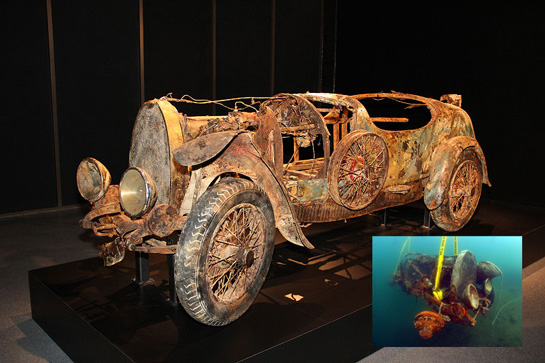
1925 Bugatti Type 22 Brescia Roadster Chassis No. 2461. On July 12, 2009, in front of an assembled crowd of more than 2000 people, this Bugatti was lifted from Lake Maggiore where it lay submerged for nearly 75 years. The full story is on display with the vehicle in the Mullin Automotive Museum. Photo by Hugues Vanhoolandt, insert from the Internet
Story and photos by Hugues Vanhoolandt
A clear picture of the passion of Peter Mullin
This year during our annual visit to Monterey Car Week, we were eager to visit the new Mullin Automotive Museum which was opened to the public last April. (Read about opening).
I was accompanied by two friends, but due to our schedule we could not visit the museum during normal opening hours. However, they kindly allowed us to visit the museum on the day that was convenient for us even though it was closed to the general public. We were then able to photograph the cars as Mr. Jesus Gonzales escorted us through the exhibit. There was even a small reception where we saw a movie about French cars of the 1930s. Peter Mullin was not there at the time but one of my friends, Vincent Yernaux, who is an expert on the Peugeot Darl’Mat spoke with him at Laguna.
This is surely the most beautiful Museum that I have ever seen. Mullin has succeeded in recreating a Paris Salon of the 30’s and yet they put forth a great effort to modernize that building in an ‘environment friendly way’. The visit of the museum is self guided but, as you will see below pictures, a placard explains the story of each car. We have written the contents, verbatim, of each placard within the frame of the photos shown.
We were very happy as there were no people to stand in the way of a great photo. The lighting is very suitable for pictures, even without flash. We stayed more than three hours in the Museum and it was not enough; we’d love to return again.
Our advice for those wishing to visit the Mullin Automotive Museum, (only ten dollars for adults) is to take time to stroll around these beautiful bodies (some are more sculptures than cars) and be sure to read the placards–don’t just go to see the ‘most expensive car in the world’. And where else can one see Bugatti furniture?.(Read Larry Crane on Bugatti Furniture).
A wonderful Museum, and our sincere thanks to the staff for allowing us to visit.
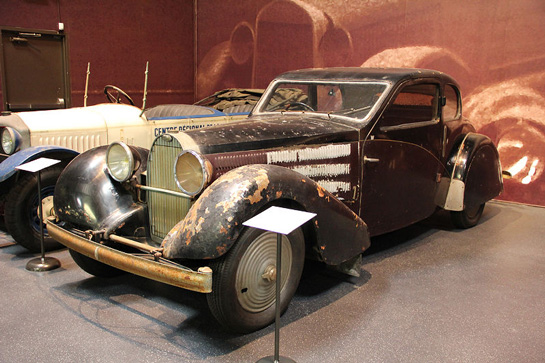
1936 Bugatti type 57 Ventoux Coupe Coachbuilder: Factory. Chassis 57377. 1936: Car was originally delivered to a client named D. Saint, probably in exchange for another car. 1960s: Nothing is known about subsequent owners until it was purchased by wealthy collector John Shakespeare. He sold it to Fritz Schlumpf in 1964 for $400. This automobile is now part of the Schlumpf Malermspach Reserve Collection of the Mullin Automotive Museum.
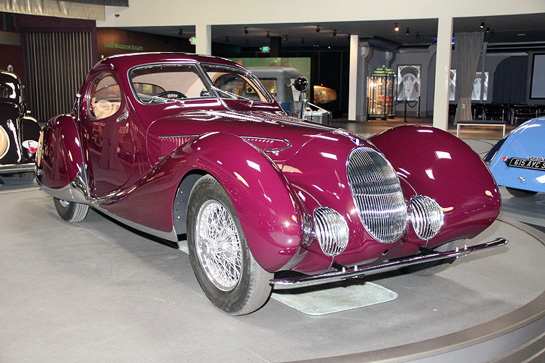
1938 Talbot Lago T150CS “Goutte D’Eau” Coachbuilder: Figoni & Falaschi. Chassis 90106. 1938: This car was originally ordered by Woolf Barnato, a well known 1930s playboy, race card driver and financier. 1950s: The car was brought to the United States by Otto Zipper in the 1950s and subsequently displayed at the Cunningham Museum. It was then sold to Peter Giddings and resold to John Cally, president of Warner Bros. 1980s: It was told to Pat Hart who undertook a 10 year restoration. 1991: Peter Mullin purchased the car and completed the restoration.
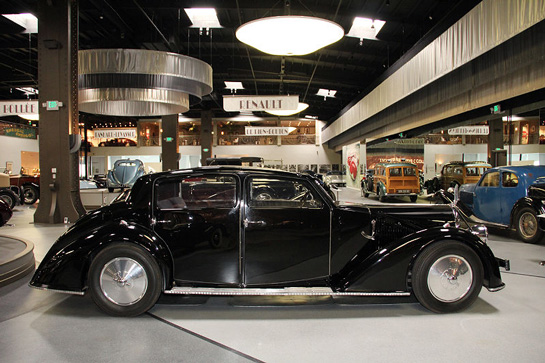
1936 Voisin C28 Clairiere Saloon. Coachbuilder: Factory. Chassis CG 28917 1936: This car was originally delivered to the French Embassy in Berlin, when new. 1940s: It was later returned to France after the war and came into the possession of Gabriel Voisin. 1960s: The car was in the care of Serge Pozzoli. It was sold to two French collectors in the 1980s. 1990s: Purchased by Peter Mullin. The Clairiere was built atop several different chassis, accounting for a total of 30 chassis built. The most powerful version was the C28 with just over 100 hp. There are only two 3.3 liter C28s in existence. This car is one, the other is in the Schlumpf Museum in France.
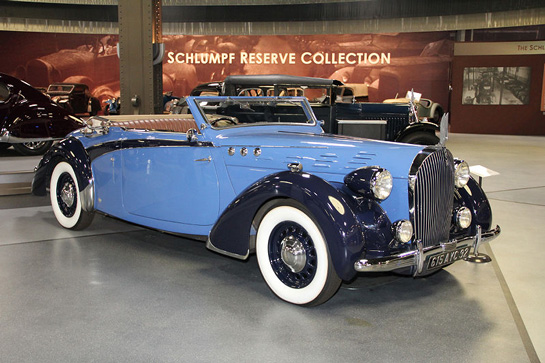
1938 Voisin C30 Cabriolet Coachbuilder: Louis Dubos. The Dubos coachwork done on this cabriolet was never repeated. It is one of a kind. Chassis 60007. 1930-40s: This C30 was requisitioned by the Germans during the war. After the war, Robert Corniere, a Voisin collector, recovered the car. It was restored in the 1990s by D. Tessier at Tours and then purchased by Peter Mullin. When this C30 was created G. Garabedian had just taken over the Avions Voisin automobile company. He asked Gabriel Voisin to design a dnew model to be shown alongside the Voisin bodied 30S Coupe. Gabriel was unable, but Louis Debo was hired instead. It was then shown at the 1938 Paris Salon. Production of C30s were halted at the outbreak of WWII, Before the Avions Voisin factory was converted to and airplane engine repair facility by the occupying power, there were approximately 30 C30 chassis produced. Five are known to exist.
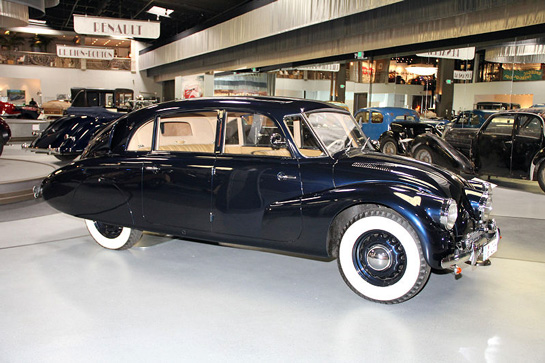
1938 Tatra Type 87 4 Door Saloon. Coachbuilder: Factory. Chassis 46089: The Type 87 was the second model from the Czechoslovakian vehicle manufacturer Tatra. Tatra is the third oldest car maker in the world after Daimler and Mercedes Benz. The company started as a carriage and wagon manufacturer in 1850. Tatra ceased car production in 1999, bu the company still produces a wide range of primarily all wheel drive trucks. The Type 87 model replaced the Type 77 which was the world’s first production aerodynamic car. The large rear fin of the Type 87, almost non existent rear windows, and third central headlight gave the car a very distinctive appearance as it sped down the autobahn during WWII. With its production limited to just over 3000, this car paved the way for the rear engine, air cooled Volkswagen Beetle. Hans Ledwinka, an Austrian engineer, was responsible for designing very advanced streamlined cars such as the Tatra during the 1930s. It was Ferdinand Porsche who used Ledwinka’s design concepts in the creation of the Volkswagen Beetle. Tatra sued Volkswagen and won a settlement many years later in 1961.

1936 Bugatti Type 57SC Atlantic Coupe. Coachbuilder: Bugatti Chassis 57374. 1936-1941: Originally purchased by Victor Rothschild of the illustrious Rothschild family. 1941: Sold to TP Tunnard Moore. 1942: Sold to Robert Arbuthnot, member of Scottish banking family who raced the car at Brooklands before WWII. 1944: Sold to Rodney Clarke, an engineer and the driving force behind Connaught Grand Prix Cars. 1945: Sold to Robert B. Oliver of Beverly Hills. 1971: Sold to Dr. Peter Williamson, an noted neurologist and Bugatti enthusiast. 2010: Purchased by an anonymous donor and is now on loan to the Mullin Automotive Museum. The Atlantic was an automobile derived from Bugatti’s prototype Aerolithe Electron Coupe that caused a sensation when it was unveiled at the 1935 Paris Auto Salon. This 1936 car was the first in the series of three Atlantics built between 1936 and 1938.
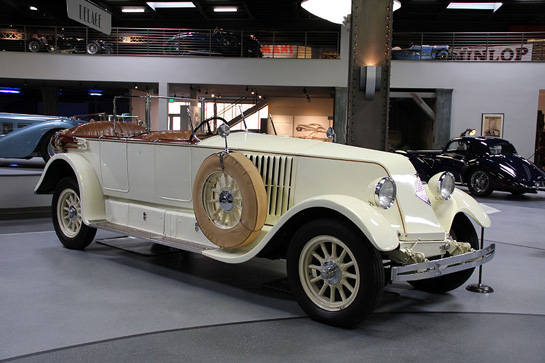
1927 Renault 40 CV Tourer. Coachbuilder: Billancourt Chassis 25927. Between 1921 and 1929 the 10CV and the 40 CV Renault models had great successes. This period in the history of the Renault automobile considered one of the most creative. In 1925 the diamond symbol of the Renault becomes the official logo of the company and is first seen on a 40 CV. 4 wheel brakes become standard at this time. In 1927, when this 40 CV was built, George Estienne crossed the Sahara in Renault NM. The car completes the 10,000 mile journey without a mechanical breakdown. The Renault is then dubbed the car that will ‘never break down.’
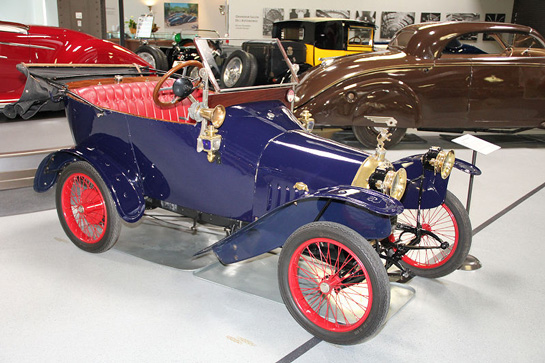
1913 Peugeot Bebe Cabriolet. Coachbuilder: Factory Chassis 10252 The original ‘Bebe’ or ‘Baby’ Peugeot was designed by Ettore Bugatti in 1911. It was licensed to Peugeot after the German company, Wanderer, turned it down. It would become the largest selling Bugatti designed car. It was immediately popular due to its size and modern look. It had advanced design for its time with rack and pinion steering and a driveshaft instead of a chain. The car’s specifications inspired other European manufacturers to design small scaled automobiles. The car made up 80 percent of Peugeot production for the first year. This model was produced between 1905 and 1916 and exported to several countries including Britain.
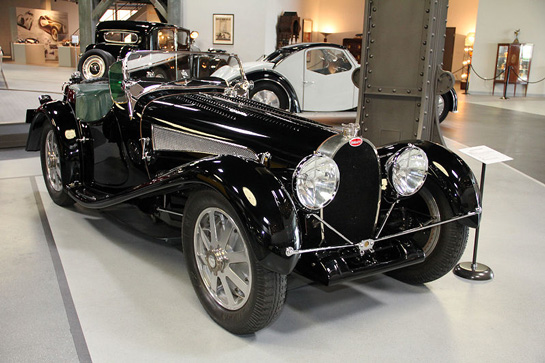
1931 Bugatti Type 54 Roadster. Coachbuilder: O. Uhlik. Chassis 5422033. 1930s: This Type 54 was sold to Prince George Christian Lobokwitz. He was killed in the car at Avus in 1932. The remnants of the car, bent frame and all, were sold to Czech race driver Zdenek Pohl. Pohl removed the Spartan 2 seater Grand Prix body and commissioned a luxury roadster. It was later owned by Phil Berg and then sold to Peter Mullin. In 1932, a Type 54 sent the world’s ‘one hour record’ at Avus with an average speed of 132.87 mph.

1934 Voisin C27 Aerosport. Coachbuilder: Voisin. Chassis 47385. With sales dwindling in the 1930s, Gabriel Voisin began producing more refined and better engineered automobiles. First came the C24 Aerodyne introduced at the Paris Salon in 1933. Its art deco appearance signaled a new direction for the Voisin automobile. It was followed by the C26 with its long wheelbase and then the shorter and underslung C27. The uniquely designed C27 Aerosport was first shown at the 1935 Geneva Auto Show. The Aerosport features a piano-hinged doors, pentagon side windows and a unique sliding roof with its own engine working off the main engine’s vacuum. The car has a striking art deco patterned interior and offer ample room for luggage.
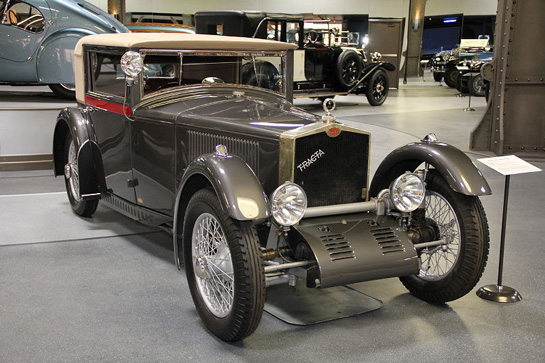
1935 Tracta D2 9CV Faux Cabriolet Coachbuilder: Ringlet of Leige. Chassis 533. 1933: This car was originally owned by George Meurice. 1965: The car several owners after Mr. Meurice: Adrien Maeght, Bruno Vendiesse, and Laurent Rondini. 2009: The car was purchased by Peter Mullin. The Tracta was designed by Jean Albert Gregoire, a French engineer, inventor and race car driver. Gregoire is considered a front wheel drive pioneer who also patented a driveshaft system. His Tracta race and road cars were highly successful in the 1920s. It was a front wheel drive Tracta that one first in class at Le Mans in 1927. Only 110 Tracta D2s were made before production ceased in 1934.
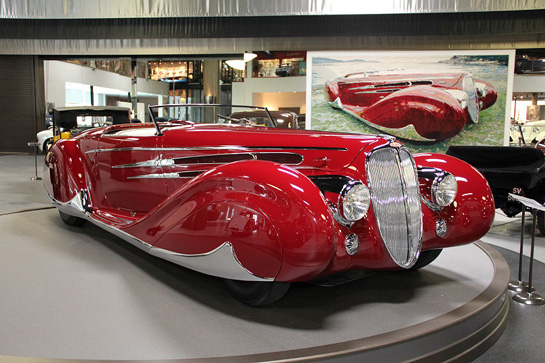
1939 Delahaye Type 165 Cabriolet. Coachbuilder: Of all the Figoni & Falaschi designs, this is considered to be the most elegant and harmonious. Chassis 60744. 1939: This car was originally built for the 1939 New York World’s Fair. The Delahaye T165 was originally developed from the famous T145 V12 Delahaye race car. A functioning V12 engine could not be installed in time for the fair so an empty core was installed while the designated engine remained in Paris. After the fair, the car was held in customs until the end of the war. 1946: It was then bought by Roger Barlow in 1946. He had a Cadillac V8 engine installed in the car. 1981: The cars was later found in Fresno in 1981 and was purchased by Jim Hull and Peter Mullin. Peter Mullin had the car remarried with an original V12 engine acquired from Count Doenhoff in Germany. The cars underwent an eight year restoration.
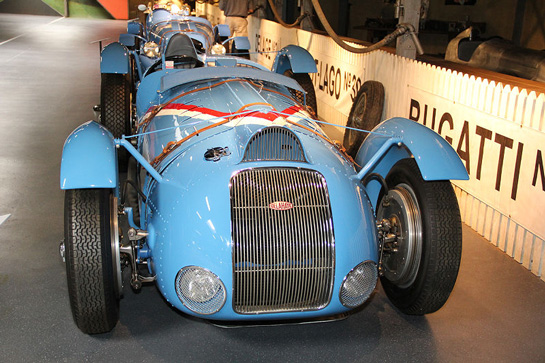
1937 Delahaye Type 145 V12 Grand Prix. Coachbuilder: Factory. Chassis 48771, 1938: After extensive research this car was discovered to be the ‘million franc’ prize race car driven by Rene Dreyfus who won the Grand Prix de Pau in 1938. The ‘Prix du Million’ was an effort by the French government to induce French automobile manufactures to develop a car that would beat the Germans who dominated racing at the time. The prize was a million francs. When World War II broke out the car was disassembled and hidden from the invading Germans. After it was reassembled the identity of the car was lost. This car was purchased by Jim Hull and Peter Mullin. Subsequent research revealed this particular car was the Million Franc Delahaye. The announcement of the cars fascinating past was made by Peter Mullin at the 2006 Pebble Beach Concours d’Elegance.
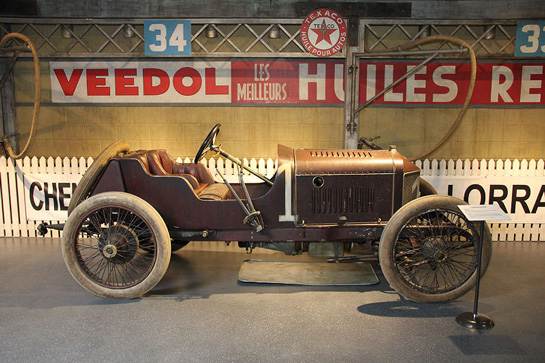
1911 Hispano Suiza Type 15 Alfonso XIII Roadster. Coachbuilder: Factory. Chassis 814. 1911: Research shows that chassis 814 was delivered to Roulina de Villeneuve in 1911. 1960s: Little is known about the ownership until the 1960s when what remained of the car was found by Francisco de le Rocha. 2001: Purchased by Peter Mullins and completely restored. This model was named after the King of Spain, a devoted Hispano Suiza owner and automotive enthusiast. In 1909 King Alfonso XIII drove a Type 15 from Madrid to San Sebastian (288 miles) at top speed. He gave royal permisssion for the model to be named after him. The car was the creation of one of the Hispano Suiza founders, Swiss engineer Mark Birkigt. The Type 15 has a steel engine was the precursor to designs for cast aluminum aircraft engines in WWI.
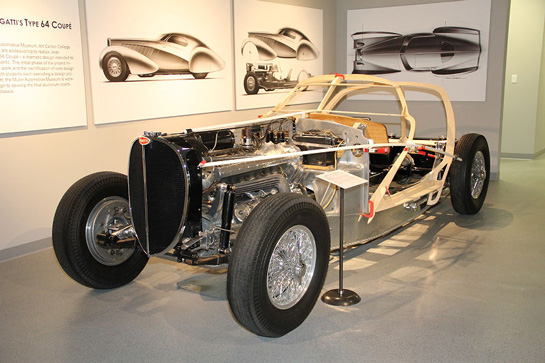
1939 Bugatti Type 64 Coupe Chassis. Coachbuilder: The Type 64 was conceived by Jean Bugatti in 1939 and designed by Pichetto under Bugatti direction. The chassis is composted of a duralumin frame. Chassis: 64002. 1939-19560: This Bugatti T64 chassis, one of two, was stored at the Bugatti Works Factory until 1960 when Jean De Dobbeleer bought them both. 1961: The chassis was sold to Gene Cesari in 1961, then to Eri Richardson who had a Type 64 engine place in it. Uwe Hucke, Charles Howard, Oscar Davis, Albert Voorhuis and Charles Bronson were subsequent owners. The chassis is currently owned by the Peter Mullin Automobile Museum Foundation. The Type 64 was based on the Type 57 coupe. The Type 64 was one of the many prototypes that failed to enter full production after their launch. The Type 64 was engineered to deliver around 170 hp with a top speed of 120 miles per hour.
To all interested:
the Excavation firm has made lots of photos:
http://www.boerlin.com/sub/inde_d.htm
Leftside: ASCONA BUGATTI.
There are (of course) some films of the lifting of this amazing Bugatti on’youtube’
Regards Michael
It’s time to update your information. There were four Atlantics: 57374, 57453, 57473, and 57591.
Why is it called the Mullin “Museum”? If it is only open “by appointment on selected Saturdays”, isn’t it really a private collection that the public is occasionally permitted to pay to see?
Lance,
As we stated in the introduction, the information in the captions is taken verbatim from the placards. We double checked and yes, the placard does indeed state three rather than four. You’ll have to ask them about that and the selected hours of operation.
Pete Vack
Hard to get reservations. I’ll see it for the first time on the 25th..